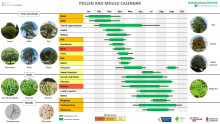In brief
The grass pollen season is in full swing, with concentrations frequently exceeding the critical threshold of 50 grains/m³. People allergic to this type of pollen should be especially cautious: symptoms can be severe and persistent. Pollen levels will generally remain very high in the coming weeks, especially during dry and sunny weather.
Summer weather conditions are favorable to the development of certain allergenic molds. Concentrations of spores from the genus Cladosporium are currently very high. This spore type is one of the most common outdoor allergens in summer, and can cause respiratory symptoms in sensitized people.









